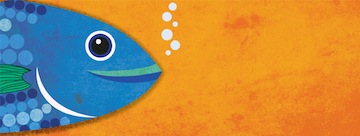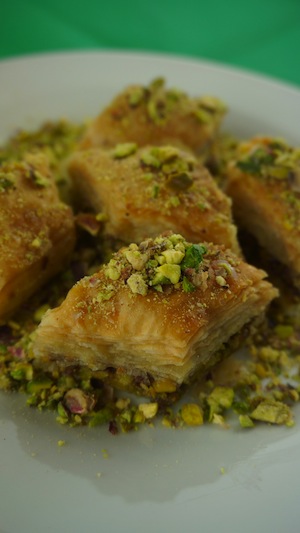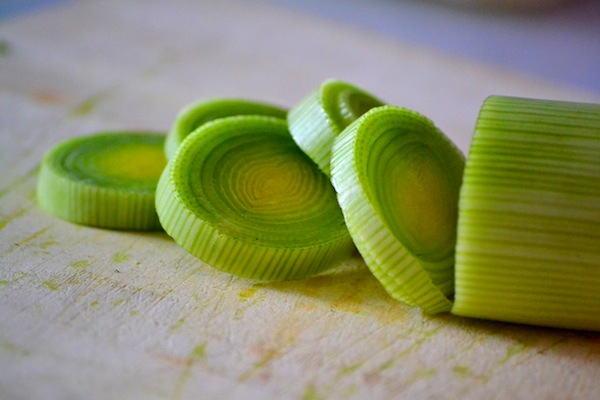At a Sephardi Rosh Hashanah seder, one of blessings, over leeks (or cabbage) is the request, may “our enemies be destroyed.” (photo from Wikimedia)
Food customs differ among Ashkenazi and Sephardi Jews. For example, whereas Ashkenazim dip apple in honey at Rosh Hashanah, some Sephardim traditionally serve mansanada, an apple compote, as an appetizer or dessert, according to The World of Jewish Desserts by Gil Marks, z”l.
Just as gefilte fish became a classic dish for Ashkenazi Jews, baked sheep’s head became a Rosh Hashanah symbol for many Sephardi Jews, dating back to the Middle Ages. Some groups serve sheep brains or tongue or a fish with head, probably for the same reasons, for fruitfulness and prosperity and wishes for the New Year of knowledge or leadership.
The Talmud mentions the foods to be eaten on Rosh Hashanah as fenugreek, leeks, beets, dates and gourds, although various Jewish communities interpret these differently.
According to Rabbi Robert Sternberg, in The Sephardic Kitchen, Sephardi Jews have a special ceremony called the Yehi Ratsones (Hebrew for “May it be Thy will”), where each food is blessed. There are foods that symbolically recognize God’s sovereignty and our hope He will hear our pleas for a good and prosperous year.
The Hebrew word for gourds is kara, which sounds like both the word for “read/proclaim” and the word for “tear.” When we eat the gourd or pumpkin, there are two possible Yehi Ratzons that can be said. The first one goes: “May it be your will, Hashem, that our merits be read/proclaimed before you.” The other is that the decree of our sentence should be torn up.
The second food mentioned is fenugreek, or rubia, which sounds like yirbu, the Hebrew word for “increase.” Therefore, we say a Yehi Ratzon that contains the request, may “our merits increase.”
The word for the third food, leeks or cabbage, is karsi, krusha or kruv, which sounds like kares, or the Aramaic word karti, to cut off or destroy. The Yehi Ratzon asks, may “our enemies be destroyed.”
The fourth food, beets or beet greens, silka or selek, sounds like siluk, meaning removal, or she’yistalqu, to be removed, or the Aramaic word silki. The Yehi Ratzon requests that “our adversaries be removed.”
The last food is dates, tamri or tamar, which sounds like the Hebrew word sheyitamu and the Aramaic word tamri, to consume. Hence, we say a Yehi Ratzon that asks, may “our enemies be consumed.”

All of these foods, which grow rapidly, are also symbols of fertility, abundance and prosperity. Among other items that might be on a Sephardi table at Rosh Hashanah, Sternberg includes baked apples dipped in honey or baked as a compote with a special syrup; dates, which were among the seven species found in Israel; pomegranates, which have many seeds, or black-eyed peas, to represent our hoped-for merits; rodanchas, a pastry filled with pumpkin whose spiral shape symbolizes the unending cycle of life; and a fish head, symbolizing a wish to be the head in life, a leader, and not the tail. The main course might feature stuffed vegetables, symbolizing a year full of blessings and prosperity.
Some communities ban sharp, bitter or black foods for Rosh Hashanah, such as black olives, eggplant, chocolate or coffee.
In The Classic Cuisine of the Italian Jews, Edda Servi Machlin, z”l, who grew up in Pitigliano, Tuscany, explains that her father held a seder for Rosh Hashanah around the theme of growth, prosperity and sweetness. On the seder plate were a round challah, a boiled rooster’s head, fish such as anchovies, boiled beets, figs and pomegranates. In the centre was a dried, round, sourdough cake with an impression of her father’s right palm and fingers, and fennel weed growing on each side.
The foods were then blessed – “May we grow and multiply like fish in the ocean, like the seeds of a pomegranate, like the leavening, grain and fennel of the bread. May the year be sweet like beets and figs.”
The meal consisted of soup, fish, salad, chicken and fruit. Italian Jews also often serve at Rosh Hashanah desserts made with honey and nuts; stick or diamond-shaped cookies; strufali, cookies made of fried dough balls in honey; or ceciarchiata, cookies that resemble chickpeas and are made from bits of dough like the Ashkenazi teiglach.
A Greek cookbook writer from Ioannina (Yahnina) wrote that the people of her area made koliva, a thick porridge of wheat berries flavoured with cloves, cinnamon, walnuts and honey for eating on the eve of Rosh Hashanah. According to Marks in The World of Jewish Desserts, wheat berries are unprocessed whole wheat with the outer husk removed, leaving a nutty flavour and chewy texture. Jews of Yahnina also ate kaltsoounakia, a half-moon-shaped cake stuffed with ground walnuts, honey, cinnamon and cloves. For the main course, dishes in Yahnina were influenced by the Turkish occupation and included stuffed tomatoes, stuffed squash and stuffed vine leaves – filled with lamb, rice and parsley, as well as okra stewed with chicken.

Other Jews of Greece have different customs. Nicholas Stavroulakis, author of Cookbook of the Jews of Greece, writes that some people soak apples in honey or eat quince or rose petals cooked in syrup as the New Year sweet. Fish is often the main course and, in place of honey cake for dessert, Greek Jews use almonds or pumpkin in making turnovers, as a symbol of abundance. Other desserts include semolina cake in syrup, pastry triangles filled with nuts or dried fruit, or baklava.
Among Jews of Syria, sugar or honey is substituted for salt at the table, and many families do not serve any dishes that are sour. For the second night Shehechiyanu blessing, the fruit used may be quince, prickly pear, star fruit or figs. Instead of, or in addition to, dipping apples in honey, Jews of Syria often dip dates in honey.
Many Jews from Muslim countries also eat autumn foods cooked with sugar and cinnamon; the food names contain a symbolic allusion to prayers in Aramaic and, through alliteration, are recited over the vegetables and fruits. Syrian Jews use the same prayers but over different vegetables: leek, Swiss chard, squash, black-eyed peas, pomegranate and the head of an animal. This idea of wanting people to be smart, as symbolized by the head or brain, is observed by Jews of Tunisia in their serving of a cake made with chicken and calves brains.
Moroccan Jews take sesame seeds, warm them in the oven and eat them with apple dipped in honey to symbolize that Jews should be fruitful and multiply like the seeds and have the sweet year. They also eat the pomegranate because of its alleged 613 seeds, which symbolize the 613 mitzvot. Moroccan Jews identify the seven autumnal foods as pumpkin, zucchini, turnip, leek, onion, quince and Chinese celery, and sprinkle these with sugar and cinnamon to eat at the beginning of the meal.
Some Moroccan Jews also serve cooked lamb head as an appetizer for Rosh Hashanah. Other lamb dishes served might be lamb with prunes and almonds or lamb intestines filled with rice, meat and tomato, seasoned with cinnamon and cardamom.
Another popular dish served by Moroccans for Rosh Hashanah is couscous, the traditional North African grain, or farina. It is steamed above a stew made with meat or chicken, chickpeas, pumpkin, carrots, cinnamon and raisins. Baked fish with the head, made with tomatoes and garlic, tongue with olives, or meat and rice rolled in Swiss chard are other Moroccan New Year’s dishes. Two soups that may be served are vegetable soup with pastels, a meat-filled turnover similar to kreplach, and potakhe de potiron, a yellow, split-pea and pumpkin soup. The evening may be completed with honey-dipped “cigars,” filled with ground almonds and traditional hot mint tea.
“Cigars” are traditional for Moroccan events and can be made sweet or savoury. The sweet version is a slim roll of Phyllo pastry filled with almonds, pistachio nuts or walnuts, baked or deep fried and sprinkled with confectioner’s sugar. Savoury cigars may be filled with cheese, chicken, meat, potatoes or tuna.
For Rosh Hashanah, Jews of Egypt make loubia, a black-eyed pea stew with lamb or veal, to symbolize fertility.
Jews of Iraq cook apples with water and sugar like applesauce, as a symbol of a sweet New Year. Some also prepare a special, pale-green bottle-shaped squash, which they eat with whole apple jam and sugar. They also make the blessings over leek, squash, dates, pomegranate and peas and place the head of a lamb on their Rosh Hashanah table.
Yemenite Jews, who do not consider themselves Ashkenazi or Sephardi, dip dates in honey instead of apples; others mix sesame seeds and anise seeds with powdered sugar and dip dates in this mixture. They also eat the beet, leek, pomegranate and pumpkin, as well as a salted fish head. The main meal for Yemenites would be a soup made of chicken or meat, carrots, potatoes and the spice hawaj (a combination of black pepper, cumin, coriander and turmeric). Meat stew, cooked chicken, rice, dried fruit and nuts complete the meal.
Whatever your family’s origins, why not try something from another Jewish culture this Rosh Hashanah?
Sybil Kaplan is a journalist, lecturer, book reviewer and food writer in Jerusalem. She created and leads the weekly English-language Shuk Walks in Machane Yehuda, she has compiled and edited nine kosher cookbooks, and is the author of Witness to History: Ten Years as a Woman Journalist in Israel.

